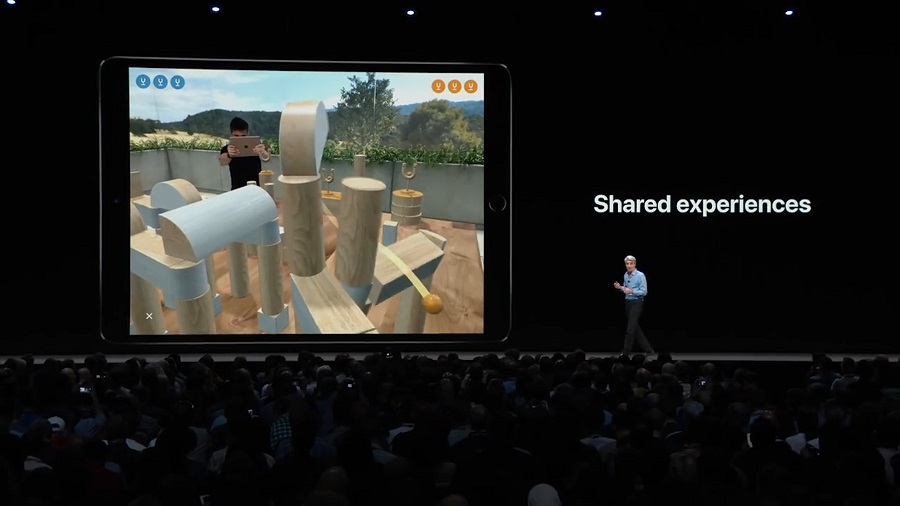Apple recently held its annual Worldwide Developers Conference, where Apple execs announce and discuss what’s to come in the next year. To say I’m excited for this year’s developments would be an understatement. Here are some of my biggest takeaways from the conference — both for developers like myself and for everyday Apple users.
Expanding augmented reality
ARKit 2, the new version of Apple’s augmented reality SDK, has two huge new features: world mapping and 3D object recognition.
{"preview_thumbnail":"/sites/default/files/styles/video_embed_wysiwyg_preview/public/video_thumbnails/-7HwupR0qEM.jpg?itok=ir-dsZ9m","video_url":"https://www.youtube.com/watch?v=-7HwupR0qEM","settings":{"responsive":1,"width":"854","height":"480","autoplay":1},"settings_summary":["Embedded Video (Responsive, autoplaying)."]}
World mapping allows you to augment an object and save its position in space. 3D object recognition is exactly what it sounds like — the ability to scan a 3D object and save it. But the exciting part is that you won’t just be able to save the 3D object; you’ll be able to share it, too.
These features combined will essentially give us the ability to create an experience in physical space and share that experience with others. I call it “experience permanence,” and I see a lot of implications and uses for this when it comes to gaming, education, and navigation — all areas that benefit from the ability to create a persistent experience based on a user’s position.
And it doesn’t have to be simply based on location! With ARKit 2, we will be able to use geofencing with GPS to trigger an experience that shows up on a specific object, at a particular latitude and longitude. For example, you might create an AR experience that lives on top of a particular table in a cafe — an experience you can only see if you break the geofence and scan that specific table with your mobile device. And two or more people would be able to view that experience, upon that table, at the same time. This tells me that Apple is focusing on simultaneous, multi-user experiences, and we’ll likely see more development from them in this area. Again, I’m most excited about the possibilities in for education — museums could have a field day with this!
This tells me that Apple is focusing on simultaneous, multi-user experiences, and we'll likely see more development from them in this area.
A brand new file type for augmented reality
Possibly one of the biggest game changers that Apple announced is that they, in collaboration with Pixar, are introducing an entirely new file format just for augmented reality. The new file format, USDZ, means we will soon be able to integrate AR experiences into web pages, documents, messages, mail, and more. Imagine you’re viewing a web page on your phone. Tap the experience and it will appear on the table in front of you, allowing you to put 3D objects into your real world. The USDZ file format encapsulates all of the media elements — 3D objects and associated files, video, and audio — into one file, which you can then embed into virtually anything. Why is this such a big deal? It means we’ll be able to deliver AR experiences without forcing the user to download an app.

Other improvements for users
Apple is promising that iOS 12, which will debut this fall, will run much faster than iOS 11 — they’re talking about a 40-60% increase in performance when it comes to opening apps on older devices.
They’re also introducing macOS Mojave Dark Mode. This is hugely helpful for people like me who stare at the same computer screen all day, since screens can be rough on your eyes and dark interfaces help to reduce optical fatigue.
Another new feature that everyone’s talking about: Screen Time. Screen Time will allow users to limit access on other devices, i.e. the parent device can control child devices. Parents can use this to monitor their kids’ screen time… or you can use it to limit your own.
Finally, Stacks! If your desktop is like mine, you’ve got a big mess of icons. MacOS Mojave will take your desktop icons and organize them into stacks: single columns on one side of your screen. Tap the stack and get a nice horizontal column with all of your icons.
These UI tweaks and new user features are great, but my big takeaway from WWDC is that Apple continues to invest its resources in the future of augmented reality. I personally am pumped for the release of ARKit 2 and can’t wait to show you what we build with it.
Header photo by Apple.



